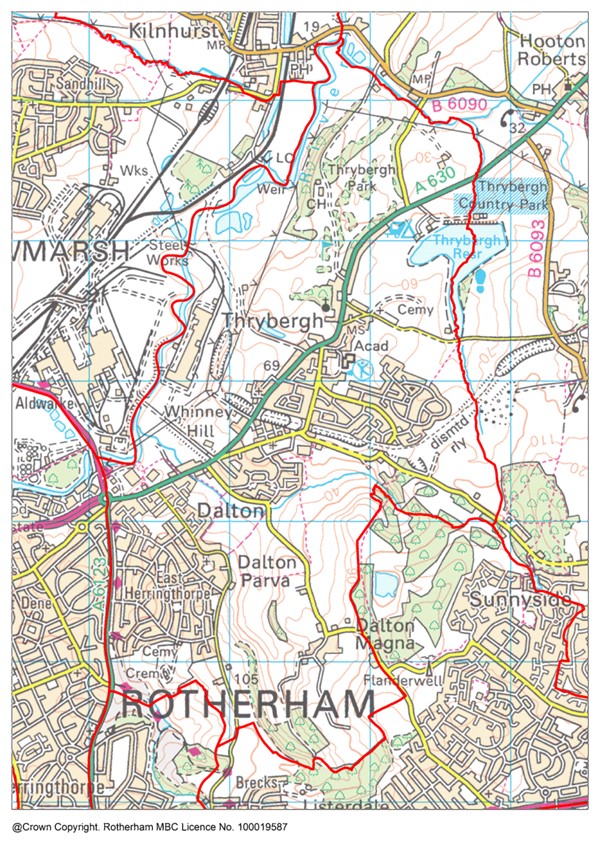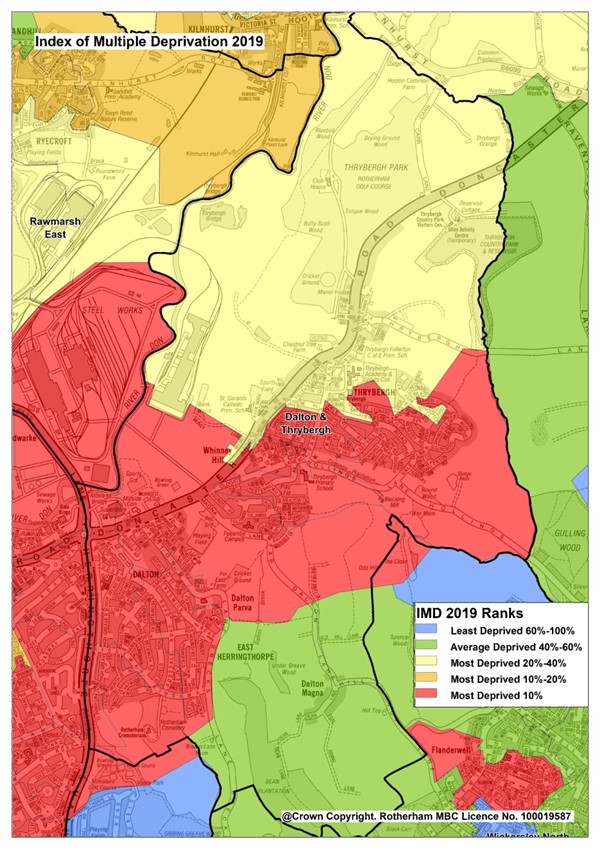Ward profile
Employment, Benefits and Pension
Crime and Anti-social Behaviour
Index of Multiple Deprivation 2015 and 2019

Description
Dalton and Thrybergh ward lies in the central part of the borough, with a population of 9,256 (2021 census).
The ward is represented by two members of the Council. Most of the population live in Dalton, East Herringthorpe and Thybergh.
These urban areas have a high proportion of council housing and high levels of deprivation, especially East Herringthorpe.
The rest of the ward covers very different areas including the small village of Dalton Magna in the east, surrounded by hilly countryside, and in the north of the ward, part of Thrybergh Country Park.
The ward is served by two parish councils, the whole of Thrybergh parish (population 4,076) and the North ward of Dalton parish (total parish population 9,797). East Herringthorpe is not served by a parish council.
Find out more about Dalton and Thrybergh on Rotherham Data Hub
Population
The population of Dalton & Thrybergh ward has increased by a slightly higher percentage since 2011 than the borough population. The age structure of the population is slightly younger than the Rotherham average with 57.2% of residents under the age of 45, compared to the borough average of 53.6%.
|
Age |
Ward Population |
Ward Percentage |
Rotherham Percentage |
|
Age 00-15 |
1910 |
20.64 |
18.89 |
|
Age 16-24 |
988 |
10.67 |
9.60 |
|
Age 25-44 |
2398 |
25.91 |
25.09 |
|
Age 45-64 |
2444 |
26.40 |
26.76 |
|
Age 65+ |
1516 |
16.38 |
19.66 |
|
Total |
9256 |
100.00 |
100.00 |
Ethnicity
Dalton and Thrybergh is among the 80% of wards in Rotherham where the white British population exceeds 90%. However, the 2020 School and Pupil Census shows ethnic minority students accounting for over 10% of the school age population, with Non-British white at 4.6% being third highest of any Rotherham ward.
|
Ethnicity |
Ward % |
Rotherham % |
England % |
|
White British |
90.90 |
88.30 |
74.70 |
|
Asian/Asian British |
1.90 |
5.30 |
9.60 |
|
White Other |
3.10 |
2.80 |
6.30 |
|
Mixed/multiple |
1.70 |
1.40 |
3.00 |
|
Black/Black British |
1.70 |
1.10 |
4.20 |
|
Other |
0.70 |
1.10 |
2.20 |
Housing
Total dwellings (2021 Census) - 4190
Total dwellings (2011 Census) - 3742
Change since 2011 (%) – 12.00
Number of households
Households (2021 Census) - 3991
Households (2011 Census) - 3742
Change since 2011 (%) – 6.70
Population Density (no. of residents per square Kilometre) 2021 Census
Ward – 1036.80
Rotherham - 927.70
Employment, Benefits and Pensions
In Dalton & Thrybergh ward the total claimant count in July 2023 is 370, which is 6.5% of the working age population. This is higher than the Rotherham average where the claimant count is 4.3% of the working age population.
Dalton & Thrybergh ward has a high proportion of local jobs in retail, health and education, but has few local jobs in manufacturing and none in wholesaling. Employment opportunities for working aged residents stand at 35%, meaning a large majority of residents will need to seek opportunities in other areas of the borough.
Health
In Dalton & Thrybergh 39.5% are in very good health, and 2.6% are in very bad health. In comparison, in Rotherham 44.2% are in very good health and 1.6% are in very bad health.
According to Census 2021, in Dalton & Thrybergh ward, 26.1% of the population are considered to be disabled under the Equality Act 2010, compared to 21.1% in Rotherham and 17.3% in England. The definition of disability in Census 2021 was: People who assessed their day to day activities as limited by long-term physical or mental health conditions of illnesses are considered disabled. Thus definition of a disabled person meets the harmonised standard for measuring disability and is in line with the Equality Act (2010).
Life expectancy
In the period 2016-2020, Dalton & Thrybergh ward's life expectancy at birth for females is 79.6 years and for males is 73.9 years. This is worse than the England average. In comparison, Rotherham's life expectancy for females is 81.3 years and for males is 77.6 years.
Disease and lifestyle
In the 2016-20 time period, the mortality ratio for deaths from strokes in Dalton & Thrybergh ward is 128.3. This is similar to England. In comparison, the lowest mortality ratio for stroke deaths in a Rotherham ward is 56.7 in Aston & Todwick ward and the highest ratio is 185.8 in Rother Vale ward.
In the 2016-20 time period, the mortality ratio for deaths from respiratory disease in Dalton & Thrybergh ward is 193.6. This is worse than England. In comparison, the lowest mortality ratio for deaths from respiratory disease in a Rotherham ward is 79.9 in Bramley & Ravenfield ward and the highest ratio is 209.1 in Rother Vale ward.
In the 2016-20 time period, the mortality ratio for deaths from coronary heart disease in Dalton & Thrybergh ward is 115.9. This is similar to England. In comparison, the lowest mortality ratio for deaths from coronary heart disease in a Rotherham ward is 76.2 in Aston & Todwick ward and the highest ratio is 152.1 in Rotherham East ward.
In the 2016-20 time period, the mortality ratio for deaths from circulatory disease in Dalton & Thrybergh ward is 130. This is worse than England. In comparison, the lowest mortality ratio for deaths from circulatory disease in a Rotherham ward is 73.5 in Aston & Todwick ward and the highest ratio is 141.9 in Rother Vale ward.
In the 2016-20 time period, the mortality ratio for deaths from cancer in Dalton & Thrybergh ward is 145.7. This is worse than England. In comparison, the lowest mortality ratio for deaths from cancer in a Rotherham ward is 94.2 in Aston & Todwick ward and the highest ratio is 152.1 in Rother Vale ward.
Obesity
In Dalton & Thrybergh ward (for the time period 2019/20-2021/22) the percentage of children in Reception (aged 4-5 years) classified as overweight or obese is 27.4%. This is worse than the England average. The percentage of children classified as obese (including severe obesity) is 15.1%. This is worse than the England average. In Rotherham overall (for comparison) the percentage of children aged 4-5 years classified as overweight or obese is 25.1% and the percentage classified as obese (including severe obesity) is 11.4%.
In Dalton & Thrybergh ward (for the time period 2019/20-2021/22) the percentage of children in Year 6 (aged 10-11 years) classified as overweight or obese is 44.7%. This is worse than the England average. The percentage of children classified as obese (including severe obesity) is 31.6%. This is worse than the England average. In Rotherham overall (for comparison) the percentage of children aged 10-11 years classified as overweight or obese is 38.8% and the percentage classified as obese (including severe obesity) is 25.1%.
Education
According to Census 2021, in Dalton & Thrybergh ward 32.5% of residents aged 16 or over have no qualifications, and 15.3% are qualified to level 4 or above. In comparison 23.4% in Rotherham have no qualifications and 23.1% are qualified to level 4 or above.
For Dalton & Thrybergh ward in 2023, there was a total of 142 pupils at the end of key stage 2, of which 100% were disadvantaged compared to 54.5% for Rotherham overall. The percentage of pupils in the ward achieving the expected standard in Reading, Writing and Maths was 42.3%, compared to 54.5% in Rotherham and 59% nationally.
For Dalton & Thrybergh ward in 2023, there was a total of 98 pupils at the end of key stage 4, of which 100% of pupils were disadvantaged, compared to 53.4%% in Rotherham overall. The average Attainment 8 score for the ward was 32.3, compared to 43.2 in Rotherham and 46.2 nationally.
Crime and Anti-Social Behaviour (ASB)
Levels of recorded crime and anti-social behavior in Dalton & Thrybergh ward are higher than the Rotherham average.
In Dalton & Thrybergh ward in 2021 there were a total of 1,372 recorded crimes. This equates to 148 recorded crimes per 1,000 population compared to 110 per 1,000 population for Rotherham.
In Dalton & Thrybergh ward in 2021, there were a total of 279 recorded incidents of anti-social behaviour. This equates to 30 recorded incidents per 1,000 population, compared to 19 per 1,000 population for Rotherham.
Index of Multiple Deprivation 2015 & 2019
Dalton & Thrybergh ward has a rank of 2 out of 25 wards in Rotherham and is in Decile 1. Of the 25 wards in Rotherham, 5 are in the top 20% most deprived in the country (deciles 1 and 2). The top 3 most deprived wards in Rotherham are Rotherham East, Dalton & Thrybergh and Maltby East.
Deprivation in Dalton & Thrybergh ward is well above the borough average and in most of the ward is also well above the national average. Five neighbourhoods, Thrybergh South, Dalton, East Herringthorpe East, Thrybergh East and East Herringthorpe North are all within the most deprived 10% in England.
In Dalton & Thrybergh ward, the proportion of all children aged 0- 15 living in income deprived families is 39.1% and the proportion of those aged 60 or over who experience income deprivation is 31.1%. Dalton & Thrybergh ward has the highest proportion of children aged 0-15 living in income deprived families. The ward with the highest proportion of those aged 60 and over who experience income deprivation is Rotherham East ward at 36.9%.

Data Sources
- Data sources contained within this document include:
- Population - ONS Census data via NOMIS Ethnicity - ONS Census data via NOMIS
- Religion - ONS Census data via NOMIS
- Housing - ONS Census data via NOMIS
- Households - ONS Census data via NOMIS
- Unemployment claimants aged 16-64 - ONS Claimant Count via NOMIS
- Types of employment - Business Register and Employment Survey via NOMIS
- General Health - ONS Census data via NOMIS
- Disability - ONS Census data via NOMIS
- Life expectancy at birth - Public Health England Fingertips
- Causes of death - Public Health England Fingertips
- Overweight and obesity in children - Public Health England Fingertips
- Highest level of education - ONS Census data via NOMIS
- Key Stage 2 and Key Stage 4 attainment - RMBC Children & Young People's Services
- Index of Multiple Deprivation - Ministry of Housing, Communities and Local Government Community assets map - OpenStreetMap via TomTom/Microsoft Corporation
- Access to green space - Green Space Index 2023 commissioned by The Ordinance Survey and undertaken by The Fields in Trust
- Crime data - www.police.uk
